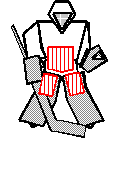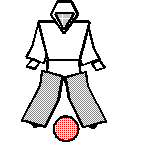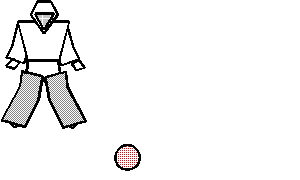|

Fig.1 Core-Muscles

Fig.2 Medicine ball training in
stand-up position

Fig.3 Medicine ball training in
butterfly position

Fig.4 Medicine ball training in
butterfly slide position
|
Train Core-Muscles
One of the most important factor to maintain your
balance in the series of explosive movement during the game is
your core-muscles. Abs, side-abs, back, thigh, ham-strings are
the main components of your core-muscles. (Fig.1) The strength
and endurance of your core-muscle help you to keep your basic
postures (stand-up, butterfly,,,) properly. When you happen to
lose your basic postures, quick response of core-muscles is essential
for getting back to the balanced position. Why do the core-muscles
play so important role in the body movement ? The reason is very
simple. They control the heaviest parts of your body; head and
trunk. So, how can you train you core-muscle??
There are several ways. Weight training like sit-up
with weight is good way to develop fundamentals. But when you
think about game like, active training, to develop real balance
and coordination on your neuro-system weight training is too static.
Medicine Ball Training
Medicine ball training is ideal method to train
your core-muscle in active body movement. It doesn't only train
your core-muscles but also develops your balance and coordination
ability through this training.
Fig.2
The basic medicine ball drills.
- The goalie without stick is standing as close
as his/her basic stance. The coach is standing in front the
goalie, about 6-10 feet away, with a medicine ball.
- The coach throws the ball to the side of the
goalie. The goalie catches the ball with both hands and throws
it back to the coach quickly.
- The coach throws it to the other side of the
goalie. Repeat 10 times each side.
- Now the coach can throw the ball ether side,
can vary the height, speed, and rhythm of the throwing. The
goalie has to react quickly and tries to maintain the balance
all the time. Repeat 10 times.
- Throughout this drill, the goalie focus
on trying to maintain his basic stance as much as possible.
The goalie can twist his/her body when he/she receives the ball,
but get back to the basic position right after he/she throws
it back.
Fig.3
The variation of basic drills, focusing on proper butterfly position
Same drill, but the goalie is in the butterfly
position.
Make sure the goalie is ;
- Standing on his/her knees. NOT sitting on the
pads.
- Back straight, upper body leaning slightly
forward.
- Toes out, closing five-hole, pads are flat
on the ice, pads face are facing forward.
Fig.4
The drills in Butterfly Slide position.
- The goalie is standing in the basic stance.
- The coach is standing 6-10 feet aside of the
goalie with the ball.
- The goalie slides towards the direction in
front of the coach in the butterfly position.
- The coach throes the ball to the goalie as
he passing by in front of him/her.
- The goalie catches the ball in the chest, trying
to maintain proper butterfly position.
- Repeat 10 times each side.
These drill can be arranged for dry-land training
too
Note:
These drill might be risky for goalies having
back problems. Also not recommended for very young kids. You might
start these drills from 12 years old with light medicine ball,
increase intensity of the drill and use heavier ball as you get
bigger and stronger.
|

